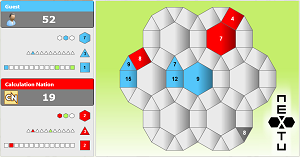 Math Concepts: Greater than, less than, tessellations, and symmetry
Math Concepts: Greater than, less than, tessellations, and symmetry
What You Can Do: For very young students, the concepts of more and less are critical in their development of number sense. Curriculum Focal Points recommends that pre-kindergarten students should be able to “compare quantities (using language such as ‘more than’ and ‘less than’)” and “order sets by the number of objects in them.”
Students have an inherent understanding of the concept from real-world experiences, especially from those arising out of fairness (“she has more raisins than I have”). However, this concept needs to be formalized through the use of counting and understanding the order of numbers. Students may be able to compare two quantities when the difference is obvious, but they may have more difficulty when the difference is small (“I have 6, you have 7”). Using various representations with students is one way to develop the concept. Using a number line to show the order of the integers is one strategy; students should understand that numbers to the right (on a horizontal scale) or above (on a vertical scale) represent greater values.
In real-world contexts, parents can foster an understanding of “more” and “less” by asking simple questions. At the grocery store, for instance, parents could ask their child, “Would you rather have this bag or that bag of cookies?” and “Which of these baskets has more strawberries?”
The game board of Nextu uses a symmetrical pattern of regular polygons. Describing and analyzing shapes, as well as understanding congruence and symmetry, are important aspects of a child’s geometric education. With geometry surrounding us, parents and teachers can foster understanding by discussing geometric shapes with children. Looking for patterns in tile floors, identifying congruent and similar shapes in a building design, and talking about the shape of musical instruments are all ways to ensure that elementary students master the basic skills necessary to succeed with more abstract geometric concepts that they’ll encounter in middle school and high school.
Math in the Game: On every turn, students match shapes to place pieces, and they also compare point values to determine if an opponent’s piece can be captured. In addition, the tessellation arrangement of the game board has an effect on strategy, because a given shape may be adjacent to 2, 3, 4, or 6 different pieces.
Related Resources:
Island Inequality Mat
Students use a context with fish swimming toward food to think about the concepts of more and less.
Tessellation Creator
The game board for Nextu consists of hexagons, squares, and triangles. The shapes form a semiregular tessellation, which is a complete covering of the plane that uses two or more regular polygons. With the Tessellation Creator, students are able to use polygons to create their own tiling patterns.
Nim Games
Students use math strategy to play variations of the classic math game, Nim.